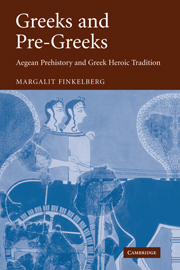Book contents
- Frontmatter
- Contents
- List of maps
- List of figures
- Preface
- List of abbreviations
- Chapter 1 Introduction
- Chapter 2 The heterogeneity of Greek genealogy
- Chapter 3 The pre-Hellenic substratum reconsidered
- Chapter 4 Kingship in Bronze Age Greece and Western Asia
- Chapter 5 Marriage and identity
- Chapter 6 The spread of the Greek language
- Chapter 7 The end of the Bronze Age
- Chapter 8 Continuities and discontinuities
- Appendix: The Testament of Hattusili
- List of references
- Index of passages cited
- General index
Chapter 4 - Kingship in Bronze Age Greece and Western Asia
Published online by Cambridge University Press: 22 September 2009
- Frontmatter
- Contents
- List of maps
- List of figures
- Preface
- List of abbreviations
- Chapter 1 Introduction
- Chapter 2 The heterogeneity of Greek genealogy
- Chapter 3 The pre-Hellenic substratum reconsidered
- Chapter 4 Kingship in Bronze Age Greece and Western Asia
- Chapter 5 Marriage and identity
- Chapter 6 The spread of the Greek language
- Chapter 7 The end of the Bronze Age
- Chapter 8 Continuities and discontinuities
- Appendix: The Testament of Hattusili
- List of references
- Index of passages cited
- General index
Summary
ROYAL SUCCESSION IN HEROIC GREECE
Contrary to appearances, Greek tradition does not make provision for royal succession from father to son. Consider, for example, the story of Pelops, a newcomer from Asia Minor, who became king in Elis in virtue of his marriage to Hippodameia, daughter of the local king Oinomaos. Although Pelops is said to have fathered many sons, it is remarkable that none of these sons succeeded him on the throne. Atreus and Thyestes, the two most prominent sons of Pelops, were exiled by their father for the murder of Chrysippos, Pelops' son by another wife. Yet, according to Pindar, Pelops fathered six sons, and other sources give him even more. All of these sons became kings elsewhere rather than in Elis itself. This compares well with the case of Peleus and Telamon, the sons of Aiakos, king of Aegina, who are also said to have killed their half-brother, Phokos, and because of this were exiled by their father: Peleus became king in Phthia, Telamon in Salamis. It goes without saying that the behaviour of Pelops and Aiakos toward their sons is strikingly at variance with what could be expected of dynastic kings, for it appears that no sons were left to succeed these kings on the throne. The next kings of Elis and Aegina must have been of a different line.
Consider also the case of Oineus and his descendants.
- Type
- Chapter
- Information
- Greeks and Pre-GreeksAegean Prehistory and Greek Heroic Tradition, pp. 65 - 89Publisher: Cambridge University PressPrint publication year: 2006



